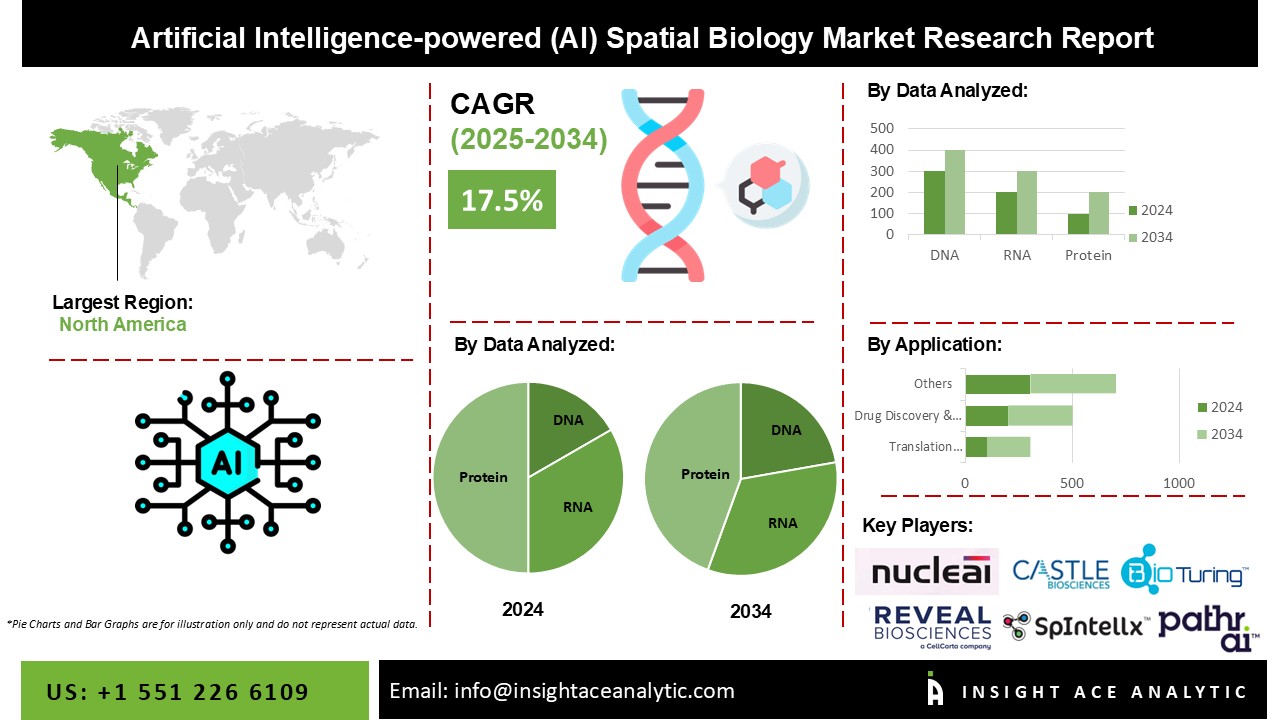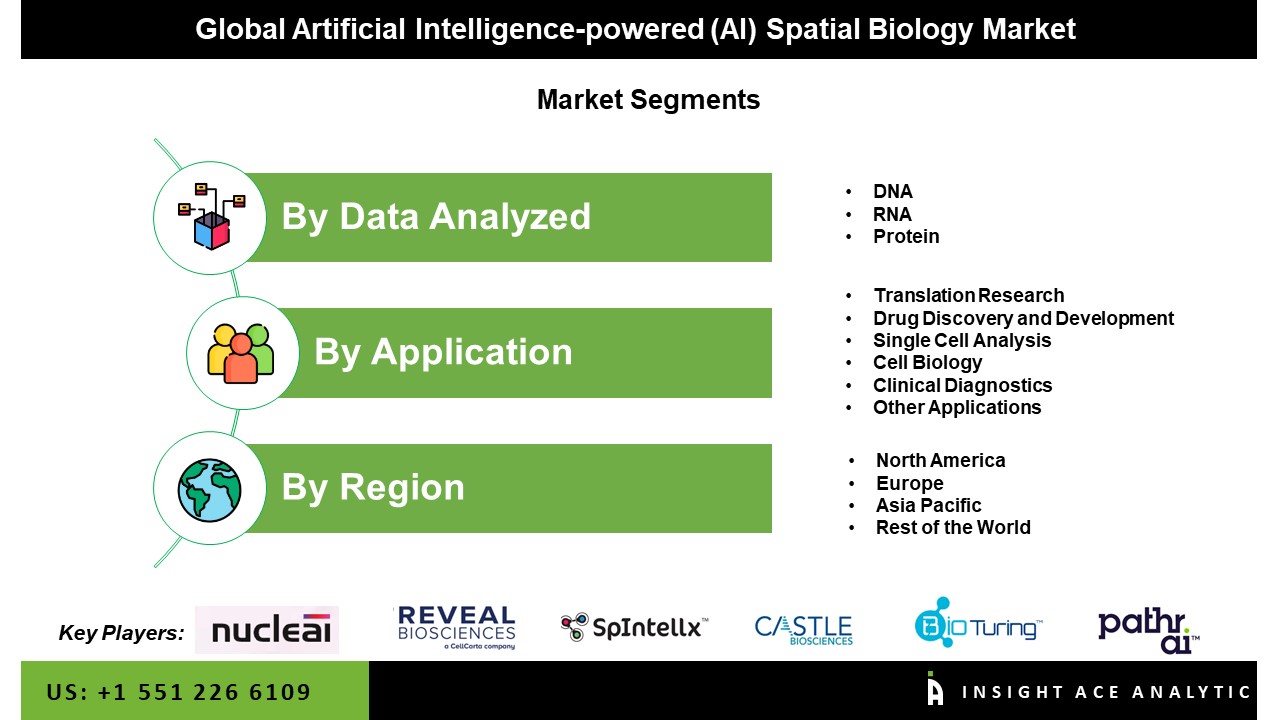Artificial Intelligence-powered (AI) Spatial Biology Market Size is predicted to reach an 17.5% CAGR during the forecast period for 2025-2034

Machine learning algorithms, a subset of artificial intelligence (AI), have the capacity to analyze "big"-sized complex data in a decisive manner. As a result, it appears to be the most helpful instrument for analyzing and comprehending multi-omics data for patient-specific observations. AI-based technology specializes in both rapidly and precisely associating the qualities found in various types of data. The usefulness of using AI is in improving the speed and accuracy of exact diagnosis and, consequently, clinical decision-making. Researchers have identified subtypes within several cancer types using AI and the crucial underlying genes, proteins, RNAs, and miRNAs that could potentially serve as therapeutic targets. Additionally correlated with biological processes are these essential indicators.
The rapidly increasing data-based AI, technological improvements in deep learning, and the growing demand for cost control and operational efficiencies in drug discovery are significantly driving market expansion. Furthermore, the rising need for treatments to treat complicated disorders such as cancer is propelling the market forward. Adopting AI can potentially reduce the extensive progress required in drug discovery and clinical diagnostics research. For instance, Rebus Biosystems Inc recently announced a collaboration with Rosalind, Inc. to co-develop new spatial omics software. The technology will democratize data from Rebus EsperTM system single-cell spatial studies, making critical spatial omics insights available to the broader scientific community.
The Artificial Intelligence-powered (AI) Spatial Biology Market is segmented on the data analysed, and applications. Based on data analysed, the market is segmented as DNA, RNA, and Protein. Based on Applications, the market is segmented as Translation Research, Drug Discovery and Development, Single Cell Analysis, Cell Biology, Clinical Diagnostics, and Other Applications.
North America dominated the market in 2021. Breakthroughs in technology, the presence of mature research infrastructure and influential companies, and rising investments in drug discovery R&D have all contributed to the growth of the regional market. North America is likely to be the leading market for artificial intelligence applications in spatial omics, driven by the region's substantial and expanding demand from research and the pharmaceutical industry. It is challenging and time-consuming to extract, analyse, and interpret biological information from images, even though new high-complexity spatial imaging approaches are now available.
| Report Attribute | Specifications |
| Growth rate CAGR | CAGR of 17.5% from 2025 to 2034 |
| Quantitative units | Representation of revenue in US$ Million and CAGR from 2025 to 2034 |
| Historic Year | 2021 to 2024 |
| Forecast Year | 2025-2034 |
| Report coverage | The forecast of revenue, the position of the company, the competitive market structure, growth prospects, and trends |
| Segments covered | Data Analyzed, Application |
| Regional scope | North America; Europe; Asia Pacific; Latin America; Middle East & Africa |
| Country scope | U.S.; Canada; U.K.; Germany; China; India; Japan; Brazil; Mexico ;The UK; France; Italy; Spain; South Korea; South East Asia |
| Competitive Landscape | Nucleai, Inc., Reveal Biosciences, Inc., Alpenglow Biosciences, SpIntellx, Inc., ONCOHOST, Pathr.ai, Phenomic AI, BioTuring Inc., Indica Labs, Rebus Biosystems, Inc., Genoskin, Algorithmic Biologics, Castle Biosciences, Inc. (TissueCypher), and Other Prominent Players. |
| Customization scope | Free customization report with the procurement of the report, Modifications to the regional and segment scope. Particular Geographic competitive landscape. |
| Pricing and available payment methods | Explore pricing alternatives that are customized to your particular study requirements. |
By Data Analyzed

By Application
By Region-
North America-
Europe-
Asia-Pacific-
Latin America-
Middle East & Africa-
Rest of Middle East and Africa
Chapter 1. Global Artificial Intelligence-powered (AI) Spatial Biology Market Research Report-2022
1.1. Research Methodology
1.2. Research Scope & Assumptions
Chapter 2. Executive Summary
Chapter 3. Global Artificial Intelligence-powered (AI) Spatial Biology Market Snapshot
Chapter 4. Global Artificial Intelligence-powered (AI) Spatial Biology Market Variables, Trends & Scope
4.1. Market Segmentation & Scope
4.2. Drivers
4.3. Challenges
4.4. Trends
4.5. Investment and Funding Analysis
4.6. Industry Analysis – Porter’s Five Forces Analysis
4.7. Competitive Landscape & Market Share Analysis
4.8. Impact of Covid-19 Analysis
Chapter 5. Market Segmentation 1: By Data Analyzed Estimates & Trend Analysis
5.1. By Data Analyzed & Market Share, 2024 & 2034
5.2. Market Size (Value US$ Mn) & Forecasts and Trend Analyses, 2021 to 2034 for the following By Data Analyzed:
5.2.1. DNA
5.2.2. RNA
5.2.3. Protein
Chapter 6. Market Segmentation 2: By Applications Estimates & Trend Analysis
6.1. By Applications & Market Share, 2024 & 2034
6.2. Market Size (Value US$ Mn) & Forecasts and Trend Analyses, 2021 to 2034 for the following By Applications:
6.2.1. Translation Research
6.2.2. Drug Discovery and Development
6.2.3. Single Cell Analysis
6.2.4. Cell Biology
6.2.5. Clinical Diagnostics
6.2.6. Other Applications
Chapter 7. Artificial Intelligence-powered (AI) Spatial Biology Market Segmentation 3: Regional Estimates & Trend Analysis
7.1. North America
7.1.1. North America Artificial Intelligence-powered (AI) Spatial Biology Market revenue (US$ Million) estimates and forecasts By Data Analyzed, 2021-2034
7.1.2. North America Artificial Intelligence-powered (AI) Spatial Biology Market revenue (US$ Million) estimates and forecasts By Therapy, 2021-2034
7.1.3. North America Artificial Intelligence-powered (AI) Spatial Biology Market revenue (US$ Million) estimates and forecasts by Applications, 2021-2034
7.1.4. North America Artificial Intelligence-powered (AI) Spatial Biology Market revenue (US$ Million) estimates and forecasts by country, 2021-2034
7.2. Europe
7.2.1. Europe Artificial Intelligence-powered (AI) Spatial Biology Market revenue (US$ Million) By Data Analyzed, 2021-2034
7.2.2. Europe Artificial Intelligence-powered (AI) Spatial Biology Market revenue (US$ Million) By Therapy, 2021-2034
7.2.3. Europe Artificial Intelligence-powered (AI) Spatial Biology Market revenue (US$ Million) estimates and forecasts by Applications, 2021-2034
7.2.4. Europe Artificial Intelligence-powered (AI) Spatial Biology Market revenue (US$ Million) by country, 2021-2034
7.3. Asia Pacific
7.3.1. Asia Pacific Artificial Intelligence-powered (AI) Spatial Biology Market revenue (US$ Million) By Data Analyzed, 2021-2034
7.3.2. Asia Pacific Artificial Intelligence-powered (AI) Spatial Biology Market revenue (US$ Million) By Therapy, 2021-2034
7.3.3. Asia Pacific Artificial Intelligence-powered (AI) Spatial Biology Market revenue (US$ Million) estimates and forecasts by Applications, 2021-2034
7.3.4. Asia Pacific Artificial Intelligence-powered (AI) Spatial Biology Market revenue (US$ Million) by country, 2021-2034
7.4. Latin America
7.4.1. Latin America Artificial Intelligence-powered (AI) Spatial Biology Market revenue (US$ Million) By Data Analyzed, 2021-2034
7.4.2. Latin America Artificial Intelligence-powered (AI) Spatial Biology Market revenue (US$ Million) By Therapy, 2021-2034
7.4.3. Latin America Artificial Intelligence-powered (AI) Spatial Biology Market revenue (US$ Million) estimates and forecasts by Applications, 2021-2034
7.4.4. Latin America Artificial Intelligence-powered (AI) Spatial Biology Market revenue (US$ Million) by country, 2021-2034
7.5. Middle East & Africa
7.5.1. Middle East & Africa Artificial Intelligence-powered (AI) Spatial Biology Market revenue (US$ Million) By Data Analyzed, 2021-2034
7.5.2. Middle East & Africa Artificial Intelligence-powered (AI) Spatial Biology Market revenue (US$ Million) By Therapy, 2021-2034
7.5.3. Middle East & Africa Artificial Intelligence-powered (AI) Spatial Biology Market revenue (US$ Million) estimates and forecasts by Applications, 2021-2034
7.5.4. Middle East & Africa Artificial Intelligence-powered (AI) Spatial Biology Market revenue (US$ Million) by country, 2021-2034
Chapter 8. Competitive Landscape
8.1. Major Mergers and Acquisitions/Strategic Alliances
8.2. Company Profiles
8.2.1. Nucleai, Inc.
8.2.2. Reveal Biosciences, Inc.
8.2.3. Alpenglow Biosciences
8.2.4. SpIntellx, Inc.
8.2.5. ONCOHOST
8.2.6. Pathr.ai
8.2.7. Phenomic AI
8.2.8. BioTuring Inc.
8.2.9. Indica Labs
8.2.10. Rebus Biosystems, Inc.
8.2.11. Genoskin
8.2.12. Algorithmic Biologics
8.2.13. Castle Biosciences, Inc. (TissueCypher)
8.2.14. Other Prominent Players
By Data Analyzed
By Application
By Region-
North America-
Europe-
Asia-Pacific-
Latin America-
Middle East & Africa-
Rest of Middle East and Africa